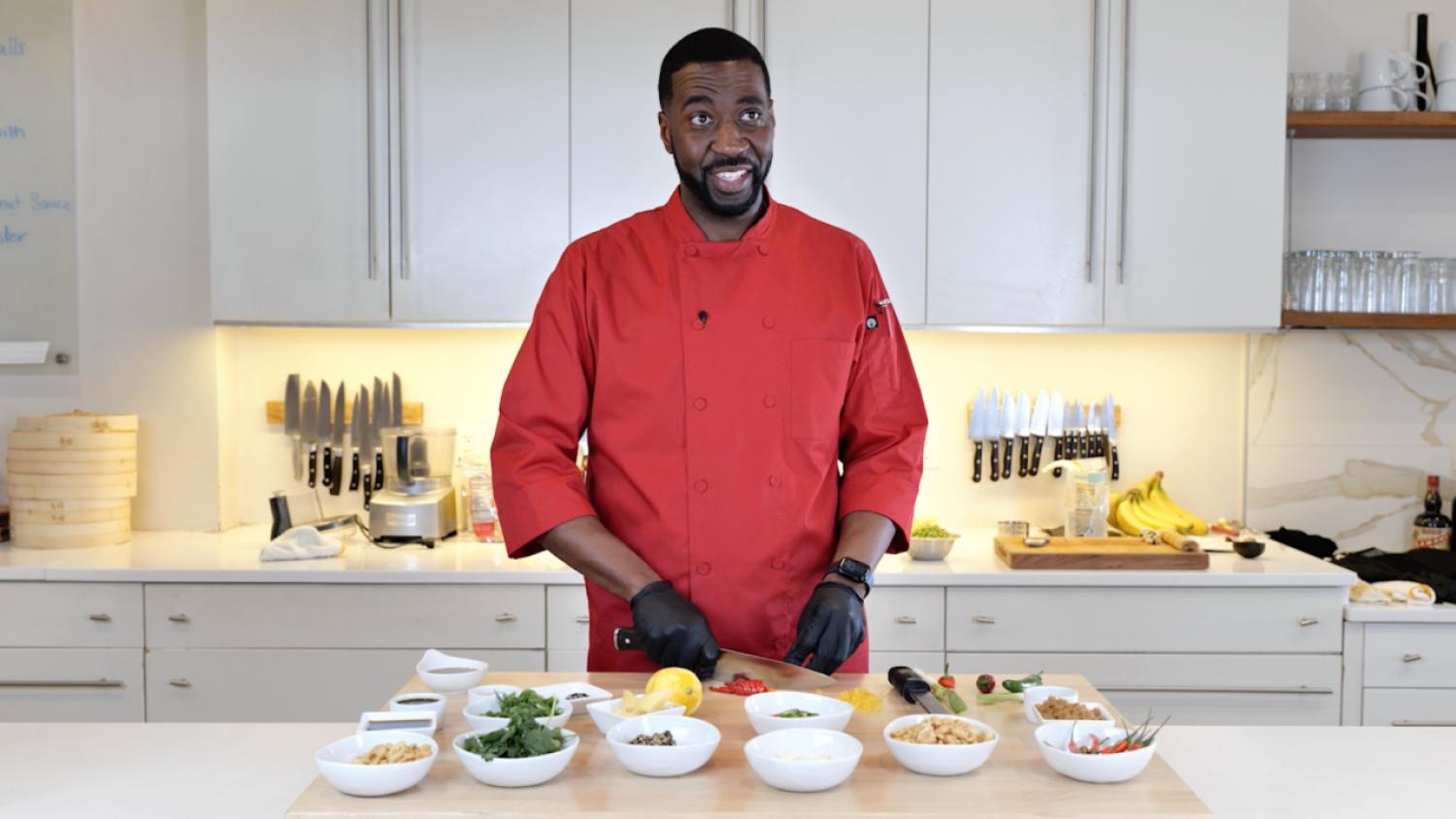As the confetti fell and thousands of lightbulbs flashed in Lyon, France, on July 7, 2019, USA’s players climbed the podium to celebrate the fulfillment of a dream that had required years of sacrifice, total commitment and a single-minded belief in accomplishing it all.
A captivated global audience delighted in what these 23 women had achieved — a historic fourth world title for the U.S. — but the players themselves took a moment to immortalize a staff member whose personal journey mirrored their own with the following chant: “Chef! Chef! Chef!”
The man they were serenading was the team’s high performance chef Teren Green, or “Chef T” as he’s affectionally known to all who’ve gotten to sample his hospitality and food.
View this post on Instagram
Green’s earliest moments of inspiration in the kitchen came from his mother, who was “pretty much superwoman” in his eyes. Consistent staples of the dinner table included tacos, fried chicken, spaghetti and a mac and cheese recipe that USWNT General Manager Kate Markgraf has described as “the best thing I’ve ever had in my life.”

When his mom worked late nights, Green began cooking these dishes for himself, his brother and friends while displaying an early knack for adding his own creative twists.
Age 18, Green knew he had a passion for cooking but also faced the pressure of a more traditional job route by attending a four-year college. At that time, he noticed a friend on social media who had a culinary job in downtown Detroit and Green was enticed by the lifestyle he saw.
His friend helped him get hired at a local oyster bar, and Green started in the dish pit, washing and doing light prep work — making the clam chowders, the crab cakes, shucking oysters and eventually moving up to the appetizer line before mastering the entrée side.
“I felt like since I was going into culinary instead of going to college traditionally for a different type of career, I felt like I had to master that craft of culinary. I wanted to be a master chef,” Green says.
But after climbing the ladder at the mom-and-pop restaurant, Green knew he wanted to find an even larger position to grow in, so he seized an opportunity to work at a luxury resort in the Adirondack Mountains of upstate New York.
It was a large scale operation with more complex management involved, and Green was assigned to all the weddings and large parties at the resort.
“I think that was the best place for me to go,” Green says. “We were cutting vegetables by the hundreds every day for the whole summer. We’re feeding 500 people at a time. We’re making plates on the conveyor belt and putting them in a warmer and sending them out. Rachel Ray came a few times and I’d been seeing her on TV around that time. She’s from the Adirondacks area. I just knew that everything had to be perfect and to her quality.”
He stayed on, moving to an Italian restaurant on the property the following summer, and ultimately spent four years at the resort until a phone call one winter — it was his mom, who’d been diagnosed with a form of blood cancer and needed to begin chemotherapy treatment.

Green immediately knew it was time to return home to help his mother, and he also knew that finding employment in Detroit wouldn’t be difficult with all the expertise and skills he’d acquired by this point. He had his choice of chef positions, and ultimately Green decided on the most prestigious: The Renaissance at General Motors headquarters with the restaurant located on skyscraper’s top floor.
He'd been there as a child when the restaurant used to spin 360 degrees to provide patrons with a panorama of downtown Detroit and his father had even worked there, so in many ways this was the ultimate homecoming from a professional standpoint. However, the traditional environment — with its repetitive menu and crowds — quickly bored Green. He knew he still needed to find his niche.
One ad that quickly caught his eye was for a hospitality company that provided the food for Palace Hills, the home of Detroit’s professional basketball team. Green had always been a huge sports fan and enjoyed watching his hometown teams, so suddenly finding himself in that space, surrounded by posters of the players and interviewing for and getting the job “was just almost a dream come true.”
Green quickly set about changing the way the team prepared for games — going from hamburgers and fast food to the celebrated meals that Chef T devised in the training center.
“I keep it really clean,” Green says. “I like to keep things natural just the way they are. I just used my skills and my creativity to create meals that I believe they liked.”
Green quickly became a player favorite with his calm and composed demeanor while he also learned how to cultivate the best and safest environment for the athletes during meal time.
“With the players, I don’t talk about basketball with them because I feel like that’s all they ever talk about,” Green says. “When they’re in the dining area, it’s not what we’re going to talk about. It’ll be on TV, and they talk about it amongst themselves. When they come and talk to me, I’m not telling them ‘good game’ or ‘bad game.’ I’m going to say, ‘How did you like the steak?’ or ‘What do you want for dinner tomorrow?’ Things like that.”
View this post on Instagram
Having found his niche, Green’s biggest opportunity yet presented itself in the form of a job link shared by a dietician he was working with. The U.S. women’s national team was looking for chef ahead of the World Cup in France and Green didn’t think twice about applying.
He went through the interview process and was quickly a part of the team’s pre-tournament training camps and send-off series. Despite his appreciation of all sports, soccer had been a relative unknown until this point.
“The first soccer game I ever went to was the farewell game the USA had in St. Louis. It was my first game and it was just epic,” Green remembers. “They had fireworks, they had people flying in with parachutes with the game ball. The team was really hyped and they won. It was so many fans, they were like banging on the bus as we’re coming in and leaving. I’d never experienced nothing like that before. I’m like, ‘This is definitely something I could be a part of; I love these girls already.’”
In France, Green adopted a hugely demanding schedule while dealing with all the issues of cooking in a foreign country. He’d wake up a 5 a.m., shower, go down and start breakfast, roll straight into preparing lunch, take a nap, come back and prepare a snack before beginning everything for dinner and then desserts.
This routine of three meals a day lasted the duration of the trip, no days off, along with the challenges of missing ingredients, language barriers with the hotel staff and an ever-growing list of requests from players (fresh squeezed juices, popsicles, collagen drinks, etc.). However, if anything was wrong in the kitchen it was left at the kitchen door.
To make it all happen, Green says he fed off the energy of the players.
“They were really outspoken, they were loud, they were excited. They were full of energy and enthusiasm. I felt I had to match their energy. It just took my whole energy to a whole ‘nother level. We fit right in with each other.”
Meal times came to represent the ultimate moments for bonding (aided by the spectacular joys of French bread and coffee). There’d be banter and jokes, led by Megan Rapinoe, who “just brings the room to life,” while Carli Lloyd set an example that every other player followed to a tee. There was also plenty of light-hearted moments — Kelley O’Hara and Rose Lavelle choreographing songs and dances for TikTok — and the development of superstitions that lasted until the final.
“The ritual was banana pancakes,” Green reveals. “Bananas cooked in their pancakes, every game day for breakfast and pregame meal. They were lined up.”
View this post on Instagram
Green’s focus was on providing the team with the right sorts of carbs prior to games for energy and endurance while making sure a lot of nutrient-dense foods were available for recovery between matches. Peanuts and peanut butter were a constant go to as a great form of fuel, and the team became devoted consumers of protein balls, PB&J sandwiches and smoothies.
Check out some of the USWNT's favorite recipes here!
Every meal was ultimately tailored for achieving the ultimate goal of lifting the trophy, and when the final whistle sounded in Lyon, Green could bask in the knowledge of having played a very large role in helping the U.S. achieve its dreams.
“It was exciting. It was like we knew it was going to happen. We been fighting this whole time, and it’s over after this. This is what we came here for. It’s like accomplishing the biggest goal,” Green says. “It was great. Ran on the field, confetti everywhere, and the girls are going to the podium and they’re getting their medals. Then that’s when they cheered for me because I’m sitting there recording them on the sidelines and they see me and they’re all just, ‘Chef! Chef! Chef!’ while they’re up there getting praised for winning. I’m like, ‘Me? You’re talking to me?!’ That’s when I fully realized that I was part of a World Cup-winning team.”
From there it was one long afterparty that’s now the stuff of legend. Green was in the dressing room as the champagne bottles popped and the ski goggles came out, and then he was at that night’s dinner party (where someone else cooked for a change).
That was followed by a private plane back to America (where a giant bottle of champagne was passed around) and a water salute from the New York City Fire Department upon landing. Green had the option of going home from there or staying for a parade through the city: “I was like, no, not going home yet.”
View this post on Instagram
Green again worked with the U.S. when they captured bronze in Tokyo before traveling with the team to Mexico last July for the Concacaf W Championship. He then went to Qatar for the men’s World Cup with Canada and will work for their women’s team at the upcoming tournament in Australia and New Zealand.
“When you’re going to these different countries, you’re really representing your country,” Green says. “I feel like it’s a big deal, it’s nothing you can take lightly. You just always got to stay on your best behavior and represent the country in a great way because sometimes in the kitchens, I see chefs from opposing teams, like the chef from Brazil will share a kitchen or a hotel together. You see him and you just him the utmost respect because you’re representing your country. I don’t take it lightly at all and I’m honored by wearing the crest.”







